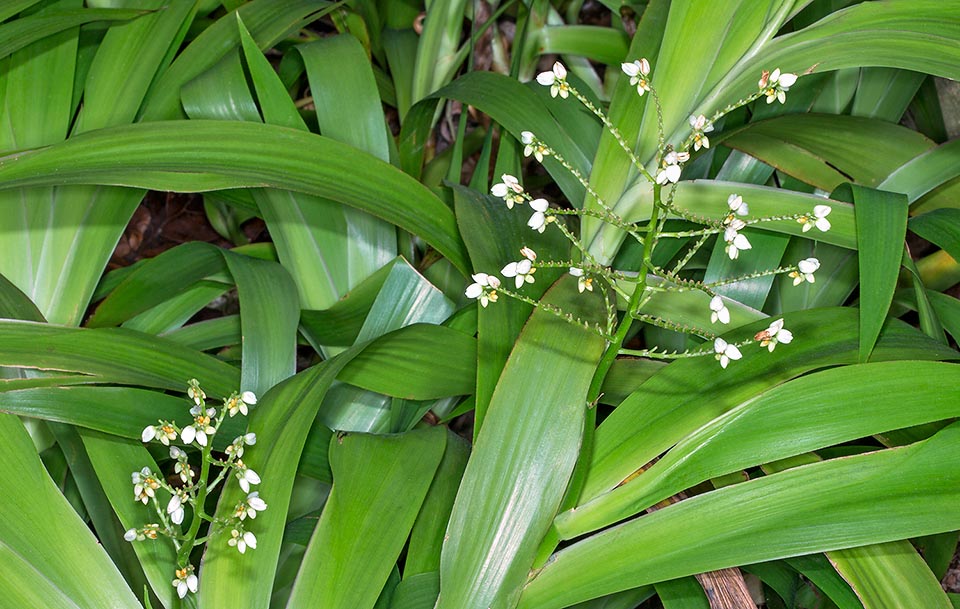Family : Haemodoraceae

Text © Pietro Puccio

English translation by Mario Beltramini
The species is native to Belize, Bolivia, Brazil (Acre, Alagoas, Amazonas, Amapá, Bahia, Ceará, Fernando de Noronha, Maranhão, Pará, Paraíba, Pernambuco, Piauí, Rio Grande do Norte, Roraima, Rondônia, Sergipe and Tocantins), Colombia, Costa Rica, Dominican Republic, Ecuador, El Salvador, French Guyana, Guatemala, Guyana, Haiti, Honduras, Jamaica, Mexico (Campeche, Chiapas, Colima, Guerrero, Jalisco, Michoacán, Nayarit, Oaxaca, Quintana Roo, Tabasco, Veracruz and Yucatán), Nicaragua, Northern Windward Islands, Panama, Peru, Southern Windward Islands, Surinam, Trinidad and Tobago, and Venezuela where it lives in the underwood of the humid forests, at the margins of the footpaths and of waterstreams, from the sea level up to about 1400 m of altitude.
The name of the genus comes from the Greek substantive “ξιφίδιον” (xiphidion) = dagger, with reference to the shape of the leaf; the specific name is the Latin adjective “caeruleus, a, um” = cerulean, light blue, with reference to the colour of the flowers of the specimen on which the species has been described.
Common names: Caribbean lily (English); camotillo de palma, carmina de sierra, cola de gallo, cola de paloma, corrimiento, espadana, manito de Dios, palma bruja, palma del norte, palmita, poderosa (Spanish).
The Xiphidium caeruleum Aubl. (1775) is an evergreen perennial herbaceous species, 0,3-1 m tall, with cylindrical rhizome, 4-20 cm long and of about 1 cm of diameter, subterraneous, horizontal, creeping, with reddish sap, and semi-erect stem, 10-30 cm long, compressed. Alternate simple leaves, distichous, linear with pointed apex, margin finely toothed towards the apex and bases wrapping the stem, 20-60 cm long and 1,5-6 cm broad, streaked, of intense green colour and glossy. Erect terminal panicle inflorescences, 8-40 cm long, with lateral ramifications almost horizontal bearing 5-25 hermaphroditic flowers, mostly white, yellowish or cerulean, of about 1 cm of diameter, with 6 ovate tepals, three external, 4-10 mm long and 1-4 mm broad, and three internal slightly smaller, three stamina and globose superior ovary.

Relative of the famous Australian kangaroo paws, belonging to the genera Anigozanthos and Macropidia, the Xiphidium caeruleum is an evergreen and rhizomatous perennial herbaceous species of Tropical America. Can be even 1 m tall and is locally utilized for various pathologies in the traditional medicine © Giuseppe Mazza
The fruits are globose trilocular dehiscent capsules, of 5-10 mm of diameter, initially green, then red-orange and finally black, containing several globose red seeds, of 0,5-1 mm of diameter.
It reproduces by seed in draining organic loam, maintained humid at the temperature of 24-26 °C, and easily by division.
Cultivated in the tropical and subtropical gardens, not bearing temperatures close to 0 °C, due to its leaves arranged in a fan and the long lasting inflorescences, for realizing borders and as ground cover, preferably in position from slightly shaded to shaded, on draining soils, rich of organic substance, maintained constantly humid, even if it is able to bear short drought periods.
The plant has also a certain utilization in the traditional medicine of the origin countries for various pathologies.
Synonymes: Ixia xiphidium Loefl. (1758); Xiphidium floribundum Sw. (1788); Xiphidium albidum Lam. (1791); Xiphidium album Willd. (1797); Xiphidium rubrum D.Don (1832); Xiphidium fockeanum Miq. (1843); Xiphidium giganteum Lindl. (1846); Xiphidium floribundum var. caeruleum (Aubl.) Hook.f. (1858); Xiphidium caeruleum var. albidum Backer (1924); Xiphidium loeflingii Mutis (1958).
→ To appreciate the biodiversity within the HAEMODORACEAE family please click here.
